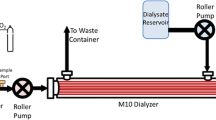Abstract
Rates of desorption of CO2 from bovine blood, as well as bovine serum, aqueous hemoglobin solutions, and water in a flat-plate-type experimental membrane blood oxygenator using silicone rubber and microporous polypropylene membranes were measured. The experimental data showed good agreement with the rigorous theoretical predictions based on an assumption that the CO2 transfer in the liquid phase is facilitated by simultaneous diffusion of bicarbonate ions produced by the instantaneous hydration of CO2 catalyzed by carbonic anhydrase existing in the red cells. Effects of screen turbulence promoters in the liquid channel were also studied. The overall resistance for CO2 transfer in membrane oxygenators including the blood phase resistance is usually smaller than that for oxygen transfer, unless the liquid phase mass transfer resistance is small relative to the membrane resistance. Thus, a membrane oxygenator designed on the basis of oxygen transfer rates will almost always have a sufficient capacity for CO2 transfer.
Similar content being viewed by others
References
Bell, G. H., Davidson, J. N., and Scarborough, H.Textbook of physiology and biochemistry, 6th ed. London: Livingstone, 1965.
Crank, J., and Nicolson, J.Proc. Cambridge Philos. Soc. 1947,43, p. 50, referred to in J. D. Smith,Numerical solution of partial differential equations. London: Oxford Univ. Press, 1965.
Dorson, Jr. W. J., and Voorhees, M. Limiting Models for the Transfer of CO2 and O2 in Membrane Oxygenator.Transactions of the American Society for Artificial Internal Organs 1974,20, 219–228.
Katoh, S., and Yoshida, F. Rates of Absorption of Oxygen into Blood under Turbulent Conditions.Chemical Engineering Journal 1972,3, 276–285.
Katoh, S., and Yoshida, F. Rate of Blood Oxygenation in a Flat Plate Membrane Oxygenator.Chemical Engineering Journal 1973,6, 51–58.
Katoh, S., and Yoshida, F. A new membrane-type blood oxygenator.Jinko Zoki (Artificial Internal Organs, in Japanese) 1974,3, 324–329.
Kigoshi, K., and Hashitani, T. The self-diffusion coefficients of carbon dioxide, hydrogen carbonate ions and carbonate ions in aqueous solutions.Bulletin of Chemical Society, Japan 1963,36, 1372.
Mockros, L. F., and Weissman, M. H. The artificial lung. InBiomedical Engineering. Philadelphia: F. A. Davis Co., 1971, P. 325.
Yoshida, F., and Ohshima, N. Diffusivity of oxygen in blood serum.Journal of Applied Physiology 1966,21, 915–919.
Author information
Authors and Affiliations
Rights and permissions
About this article
Cite this article
Katoh, S., Yoshida, F. Carbon dioxide transfer in a membrane blood oxygenator. Ann Biomed Eng 6, 48–59 (1978). https://doi.org/10.1007/BF02584531
Received:
Issue Date:
DOI: https://doi.org/10.1007/BF02584531



